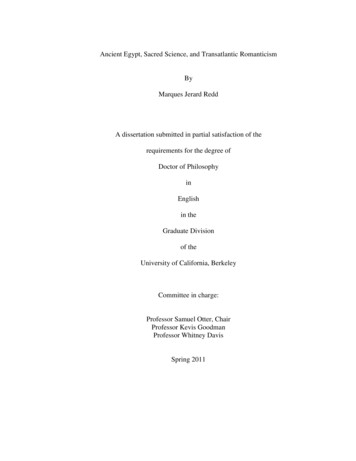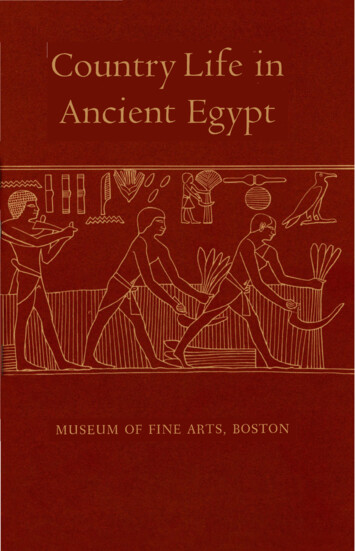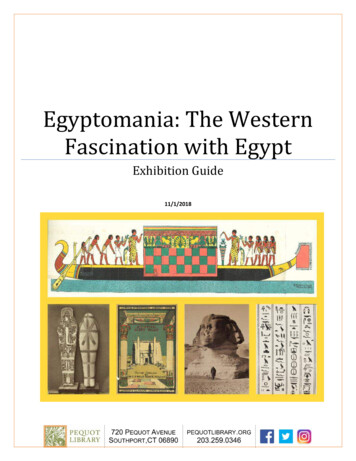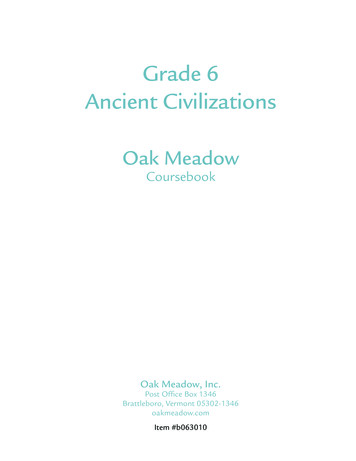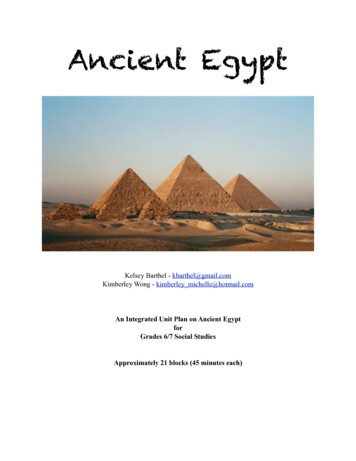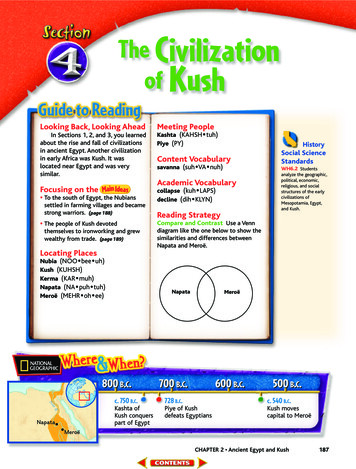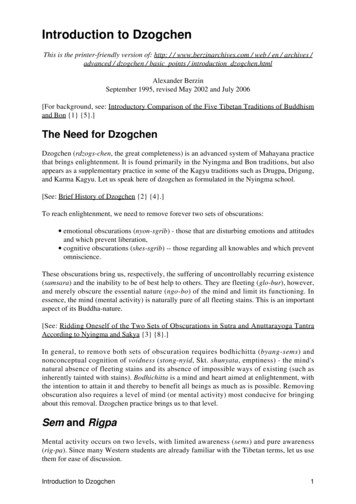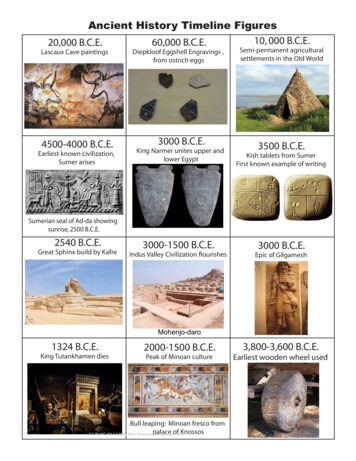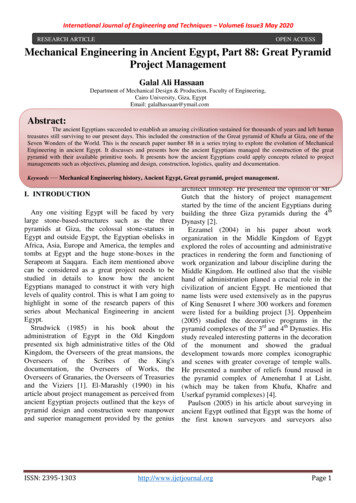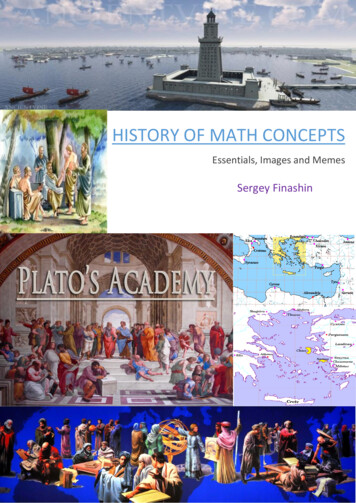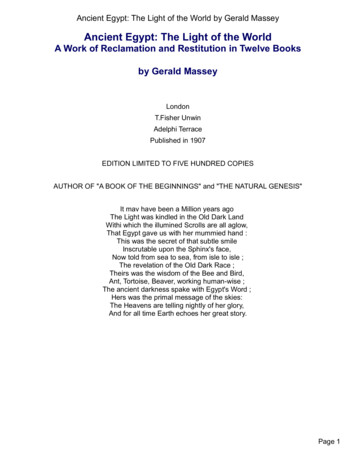
Transcription
Ancient Egypt: The Light of the World by Gerald MasseyAncient Egypt: The Light of the WorldA Work of Reclamation and Restitution in Twelve Booksby Gerald MasseyLondonT.Fisher UnwinAdelphi TerracePublished in 1907EDITION LIMITED TO FIVE HUNDRED COPIESAUTHOR OF "A BOOK OF THE BEGINNINGS" and "THE NATURAL GENESIS"It mav have been a Million years agoThe Light was kindled in the Old Dark LandWithi which the illumined Scrolls are all aglow,That Egypt gave us with her mummied hand :This was the secret of that subtle smileInscrutable upon the Sphinx's face,Now told from sea to sea, from isle to isle ;The revelation of the Old Dark Race ;Theirs was the wisdom of the Bee and Bird,Ant, Tortoise, Beaver, working human-wise ;The ancient darkness spake with Egypt's Word ;Hers was the primal message of the skies:The Heavens are telling nightly of her glory,And for all time Earth echoes her great story.Page 1
Ancient Egypt: The Light of the World by Gerald MasseyPREFATORYI have written other books, but this I look on as the exceptional labour which has made my life worthliving. Comparatively speaking, " A Book of the Beginnings" (London, 1881) was written in the dark, "TheNatural Genesis" (London, 1883) was written in the twilight, whereas" Ancient Egypt" has been written inthe light of day. The earlier books were met in England with the truly orthodox conspiracy of silence.Nevertheless, four thousand volumes have got into circulation somewhere or other up and down tltereading world, where they are slowly working in their unacknowledged way. Probably the present bookwill be appraised at home in proportion as it comes back piecemeal from abroad, from Germany, orFrance, or maybe from the Country of the Rising Sun.To all dear lovers of the truth the writer now commends the verifiable truths that wait for recognition inthese pages.Truth is all-potent with its silent powerIf only whispered, never heard aloud,But working secretly, almost unseen,Save in some excommunicated Book;'Tis as the lightning with its errand doneBefore you hear the thunder.For myself, it is enough to know that in despite of many hindrances from straitened circumstances,chronic ailments, and the deepening shadows of encroaching age, my book is printed, and the subjectmatter that I cared for most is now entrusted safely to the keeping of John Gutenberg, on this my nineand-seventieth birthday.Page 2
Ancient Egypt: The Light of the World by Gerald MasseyCONTENTS VOL. I and 2PageNumberSize Pagesin K (Approx.)Roman234ANCIENT EGYPT- The Light of the WorldIntroduction PREFATORYBOOK 1SIGN-LANGUAGE AND MYTHOLOGY AS PRIMITIVEMODES OF REPRESENTATION117239Book 2TOTEMISM, TATTOO AND FETISHISM AS FORMS OFSIGN-LANGUAGE4657960BOOK 3ELEMENTAL AND ANCESTRAL SPIRITS, OR THE GODS120AND THE GLORIFIED25653BOOK 4EGYPTIAN BOOK OF THE DEAD AND THE MYSTERIESOF AMENTA18647351-The Primitive African Paradise24986888- Egyptian Wisdom269-The Drowning of the Dragon287THE SIGN-LANGUAGE OF ASTRONOMICALMYTHOLOGY (PART II)321-Horus of the Double Horizon332-The Making of Amenta34447295-The Irish Amenta366-The Mount of Glory376BOOK 7EGYPTIAN WISDOM AND THE HEBREW GENESIS39899688BOOK 8THE EGYPTIAN WISDOM IN OTHER JEWISH WRITINGS 470BOOK 9THE ARK, THE DELUGE, AND THE WORLD’S GREATYEAR544-627294BOOK 10THE EXODUS FROM EGYPT AND THE DESERT OFAMENTA628-688222BOOK 11EGYPTIAN WISDOM IN THE REVELATION OF JOHN THE689-725DIVINE135THE SIGN-LANGUAGE OF ASTRONOMICALMYTHOLOGYBOOK 5BOOK 6Page 3
Ancient Egypt: The Light of the World by Gerald MasseyBook 12APPENDIXTHE JESUS-LEGEND TRACED IN EGYPT FOR TENTHOUSAND YEARS726-804285905-Page 4
Ancient Egypt: The Light of the World by Gerald MasseyLIST OF ILLUSTRATIONS - Volume -1ANCIENT EGYPT- The Light of the WorldBookNo.PageNo.:1APT, THE FIRST GREAT MOTHER1241THE MUMMY-BABE2193ILLUSTRATION FROM A THEBAN TOMB2894HIPPOPOTAMUS AND HAUNCH3115SHU THE KNEELER3156HORUS STRANGLING SERPENTS3177HORUS IN PISCES3438HORUS THE SHOOT OF THE PAPYRUS4509ASSYRIAN CYLINDER45310THE FLAMING SWORD WHICH GUARDED THE TREE45511HORUS BRUISING THE SERPENT'S HEAD .462Page 5
Ancient Egypt: The Light of the World by Gerald MasseyVOLUME 1BOOK 1 of 12SIGN-LANGUAGE AND MYTHOLOGY AS PRIMITIVE MODES OF REPRESENTATIONTHE other day a lad from London who had been taken to the sea-side for the first time in his life wasstanding with his mother looking at the rolling breakers tossing and tumbling in upon the sands, when hewas heard to exclaim, "Oh, mother, who is it chucking them heaps o" water about ?" This expressionshowed the boy's ability to think of the power that was " doing it" in the human likeness. But, then,ignorant as he might be, he was more or less the heir to human faculty as it is manifested in all itstriumphs over external nature at the present time. Now, it has been and still is a prevalent and practicallyuniversal assumption that the same mental standpoint might have been occupied by Primitive Man, anda. like question asked in presence of the same or similar phenomena of physical nature. Nothing is morecommon or more unquestioned than the inference that Primitive Man would or could have asked," Who isdoing it ?" and that the Who could have been personified in the human likeness. Indeed, it has becomean axiom with modern metaphysicians and a postulate of the Anthropologists that, from the beginning,man imposed his own human image upon external nature; that he personified its elemental energies andfierce physical forces after his own likeness; also that this was in accordance with the fundamentalcharacter and constitution of the human mind. To adduce a few examples taken almost at random: David Hume declares that " there is a universal tendency among mankind to conceive all beings likethemselves". In support of which he instances the seeing of human faces in the moon. Reid on the ActivePowers (4th Essay) says our first thoughts are that "the objects in which we perceive motion haveunderstanding and power as we have". Francis Bacon had long before remarked that we human beings"set stamps and seals of our own images upon God's creatures and works". (Exp. History) HerbertSpencer argued that human personality applied to the powers of nature was the primary mode ofrepresentation, and that the identification of this with some natural force or object is due to identity ofname. (Data of Sociology, chapter xxiv, 184.) "In early philosophy throughout the world", says Mr. Tylor,"the [Page2} sun and moon are alive and as it were human in their nature". Professor Max Müeller, whotaught that Mythology was a disease of language, and that the Myths have been made out of wordswhich had lost their senses, asserts that "the whole animal world has been conceived as a copy of ourown. And not only the animal world, but the whole of nature was liable to be conceived and named by anassimilation to human nature". (Science of Thought, page 503.) And "such was the propensity in theearliest men of whom we have any authentic record to see personal agency in everything", that it couldnot be otherwise, for "there was really no way of conceiving or naming anything objective except after thesimilitude of the subjective, or of ourselves". (Science of Thought, page 495.) Illustrations of this modernposition might be indefinitely multiplied. The assumption has been supported by a consensus ofassertion, and here, as elsewhere, the present writer is compelled to doubt, deny, and disprove thepopular postulate of the accepted orthodox authorities.That, said the lion, is your version of the story: let us be the sculptor's , and for one lion under the feet ofa man you shall see a dozen men beneath the pad of one lion."Myth-making Man" did not create the Gods in his own image. The primary divinities of Egypt, such asSut, Sebek, and Shu, three of the earliest, were represented in the likeness of the Hippopotamus, theCrocodile, and the Lion; whilst Hapi was imaged as an Ape, Anup - as a Jackal, Ptah as a Beetle, Taht asan Ibis, Seb as a Goose. So was it with the Goddesses. They are the likenesses of powers that werePage 6
Ancient Egypt: The Light of the World by Gerald Masseysuper-human, not human. Hence Apt was imaged as a Water-cow, Hekat as a Frog, Tefnut as a Lioness,Serkh as a Scorpion,. Rannut as a Serpent, Hathor as a Fruit-tree. A huge mistake has hitherto beenmade in assuming that the Myth-Makers began by fashioning the Nature-Powers in their own humanlikeness. Totemism was formulated by myth-making man with types that were the very opposite ofhuman, and in mythology the Anthropomorphic representation was preceded by the whole menagerie ofTotemic Zootypes.The idea of Force, for instance, was not derived from the thews and muscles of a Man. As the KaraiteSign-Language shows, the Force that was "chucking them heaps of water about" was perceived to bethe wind; the Spirit that moved upon the face of the waters from the beginning. This power was divinisedin Shu, the God of breathing Force, whose zootype is the Lion as a fitting figure of this panting Power ofthe Air. The element audible in the howling wind, but dimly apprehended otherwise, was given shape andsubstance as the roaring Lion in this substitution of similars. The Force of the element was equated bythe power of the Animal; and no human thews and sinews could compare with those of the Lion as afigure of Force. Thus the Lion speaks for itself, in the language of Ideographic Signs. And in this way theGods and Goddesses of ancient Egypt were at first portrayed as Superhuman Powers by means of livingSuperhuman types.If primitive man had projected the shadow of himself upon external nature, to shape its elemental forcesin his own image, or if the un-featured Vast had unveiled to him any likeness of the human face, [Page 3]then the primary representation of the Nature-Powers (which became the later divinities) ought to havebeen anthropomorphic, and the likeness reflected in the mirror of the most ancient mythologies shouldhave been human. Whereas the Powers and Divinities were first represented by animals, birds, andreptiles, or, to employ a word that includes all classes, they were portrayed by means of zootypes. TheSun and Moon were not considered "human in their nature" when the one was imaged as a Crocodile, aLion, a Bull, a Beetle, or a Hawk, and the other as a Hare, a Frog, an Ape, or an Ibis, as they arerepresented in the Egyptian hieroglyphics by means of the zootypes. Until Har-Ur, the Elder Horus, hadbeen depicted as the Child in place of the Calf or Lamb, the Fish, or Shoot of the Papyrus-plant (whichwas comparatively late), there was no human figure personalised in the Mythology of Egypt.Primitive or paleolithic Man was too beggarly poor in possessions to dream of shaping the SuperhumanPowers of Nature in the human likeness. There is one all-sufficient reason why he did not; he simplycould not. And it is precisely because the Makers of the Myths had not the power to animate the universein their own likeness that we have the zoomorphic mode of representation as the Sign-Language ofTotemism and Mythology. On every line of research we discover that the representation of nature waspre-anthropomorphic at first, as we see on going back far enough, and on every line of descent thezoomorphic passes ultimately into the human representation. Modern metaphysicians have so developedthe faculty of abstraction and the disease of Subjectivity that their own mental operations offer no trueguidance for generalisations concerning primitive or early man, who thought in things and almostapprehended with the physical sense-alone.They overlook the fact that imaging by means of object-pictures preceded the imagining so oftenascribed to primitive men. These did not busy themselves and bother their brains with all sorts of vagrantfancies instead of getting an actual grasp of the homeliest facts. It was not "Primitive Man" but twoGerman metaphysicians who were looking out of window at a falling shower of rain when one of themremarked, "Perhaps it is I who am doing that" "Or /," chimed in the other.Page 7
Ancient Egypt: The Light of the World by Gerald MasseyThe present writer once had a cat before whom he placed a sheet of polished tin. The cat saw herselfreflected as in a mirror, and looked for a short time at her own image. So far as sight and appearancewent, this might have been another cat. But she proceeded to apply the comparative process and testone sense by another, deliberately smelling at the likeness to find out if any cat was there. She did not sitdown as a non-verifying visionary to formulate hypotheses or conjure up the ghost of a cat. Her sense ofsmell told her that as a matter of fact there was no other cat present; therefore she was not to be misledby a false appearance, in which she took no further interest. That, we may infer, was more like the actionof Primitive Man, who would find no human likeness behind the phenomena of external nature. Indeed,man was so generally represented by the animals that the appearance could be mistaken for a primitivebelief that the animals were his ancestors. But the powers [Page 4] first perceived in external nature werenot only unlike the human; they were very emphatically and distinctly more than human, and thereforecould not be adequately expressed by features recognizable as merely human. Primitive men were alltoo abjectly helpless in presence of these powers to think of them or to conceive them in their ownsimilitude. The one primordial and most definite fact of the whole matter was the distinct and absoluteunlikeness to themselves. Also they themselves were too little the cause of anything by the work of theirown hands to enter into the sphere of causation mentally. They could only apprehend the nature-forcesby their effects, and try to represent these by means of other powers that were present in nature, butwhich were also necessarily superior to the human and were not the human faculties indefinitelymagnified. The human being could only impress his own image on external nature in proportion to hismastery over natural conditions. He could not have figured the Thunder-bolt as a Stone-axe in the handsof a destroying Power until he himself had made and could wield the axe of stone as the weapon of hisown power. But he could think of it in the likeness of the Serpent already known to him in external natureas a figure of fatal force.An ignorant explanation of the Egyptian Sign-Language was begun by the Greeks, who could not readthe hieroglyphics. It was repeated by the Romans, and has been perpetuated by "Classical Scholars"ever since. But, as the interpreter of Egypt, that kind of scholastic knowledge is entirely obsolete.Ignorance of primitive sign-language has been and is a fertile source of false belief. For example,Juvenal asks, " Who does not know what kind of monsters Egypt insanely worships?" (Sat. 15.1.) Andhaving seen or heard of the long-tailed Ape in an Egyptian temple, the satirist assumed without questionthat this animal was set up as an object of worship. He did not know that the Ape itself was theworshipper, as an image in Sign-Language and as the Saluter of the Gods. Ani, the name of thisparticular Ape, denotes the Saluter, and to salute was an Egyptian gesture of adoration. The Ape orCynocephalus with its paws uplifted is the typical worshipper as Saluter of the Light. It was, and still is,looked upon in Africa generally as a pre-human Moon-worshipper, who laments and bewails thedisappearance of its night-light and rejoices at the renewal and return of that luminary. (Hor-Apollo, B. i,14. Also Captain Burton, in a letter to the author.) In the Vignettes to the Ritual, Ani the Ape is the Saluterof the rising Sun, that is of Ra, upon the Mount of Sunrise. One of the most profound perversions of thepast has been made in misapprehending this primitive sign-language for what is designated "Worship",whether as "Sun-Worship", "Serpent-Worship", "Tree-Worship", or "Phallic-Worship". The Tree, forexample, is a type, but the type is not necessarily an object of worship, as misunderstood by those whodo not read the types when these are rooted in the ground of natural fact. The forest-folk were dwellers inthe trees, or in the bush. The tree that gave them food and shelter grew to be an object of regard. Henceit became a type of the Mother-Earth as the birthplace and abode. Hence Hathor was the hut or house ofHorus (Har) in the tree. But worship is a word of cant employed by writers who are [Page 5] ignorant ofsign-language in general. Such phrases as "Stock-and-stone worship" explain nothing and are worsethan useless. The Mother and Child of all mythology are represented in the Tree and Branch. The Treewas a type of the abode, the Roof-tree; the Mother of food and drink; the giver of life and shelter; the wetPage 8
Ancient Egypt: The Light of the World by Gerald Masseynurse in the dew or rain; the producer of her offspring as the branch and promise of periodic continuity.Was it the Tree then the Egyptians worshipped, or the Giver of food and shelter in the Tree ? On the ApisStele in the Berlin Museum two priests are saluting the Apis-Bull. This is designated "Apis-worship". Butthe Apis carries the Solar Disk betwixt its horns. This also is being saluted. Which then is the object ofworship ? There are two objects of religious regard, but neither is the object of adoration. That is the Godin spirit who was represented as the Soul of life in the Sun and in the Tree, also by the fecundating Bull.In this and a thousand other instances it is not a question of worship but of sign-language.Nor did Mythology spring from fifty or a hundred different sources, as frequently assumed. It is one as asystem of representation, one as a mould of thought, one as a mode of expression, and all its greatprimordial types are virtually universal. Neither do the myths that were inherited and repeated for ages bythe later races of men afford any direct criterion to the intellectual status of such races. A mythicalrepresentation may be savage without those who preserve it being savages. When the Egyptians in thetime of Unas speak of the deities devouring souls it is no proof of their being cannibals at the time.Mythology has had an almost limitless descent. It was in a savage or crudely primitive state in the mostancient Egypt, but the Egyptians who continued to repeat the Myths did not remain savages. The samemythical mode of representing nature that was probably extant in Africa 100,000 years ago survives today amongst races who are no longer the producers of the Myths and Marchën than they are oflanguage itself. Egyptian mythology is the oldest in the world, and it did not begin as an explanation ofnatural phenomena, but as a representation by such primitive means as were available at the time. Itdoes not explain that the Sun is a Hawk or the Moon a Cat, or the solar God a Crocodile. Such figures offact belong to the symbolical mode of rendering in the language of animals or zootypes. No betterdefinition of "Myth" or Mythology could be given than is conveyed by the word "Sem" in Egyptian. Thissignifies representation on the ground of likeness. Mythology, then, is "representation on the ground oflikeness", which led to all the forms of sign-language that could ever be employed. The matter has beentouched upon in previous volumes, but for the purpose of completeness it has to be demonstrated in thepresent work that external nature was primarily imaged in the pre-human likeness. It was the same hereas in external nature: the animals came first, and the predecessors of Man are primary in SignLanguage, Mythology, and Totemism.It is quite certain that if the primitive method had been Conceptual and early man had possessed thepower to impose the likeness of human personality upon external phenomena it would have been in theimage of the Male, as a type or in the types of power; whereas the primal human personification is in thelikeness of the female. [Page 6]The great Mother as the primal Parent is a Universal type. There could beno divine Father in Heaven until the fatherhood was individualized on earth. Again, if primitive men hadbeen able to impose the human likeness on the Mother-Nature the typical Wet-nurse would have been awoman. But it is not so; the Woman comes last She was preceded by the Beast itself, the Sow, theHippopotamus, or Lioness, and by the female form that wears the head of the Zootype, the Cow, Frog orSerpent, on the body of a divinity. Moreover, the human likeness would, of necessity, have included Sex.But the earliest powers recognised in nature are represented as being of no Sex. It is said in theAkkadian hymns, "Female they are not, male they are not" Therefore they were not imaged in the humanlikeness. The elements of air, earth, water, fire, darkness and light are of no sex, and the powers firstrecognised in them, whether as destructive or beneficent, are consequently without sex. So far fromNature having been conceived or imaged as a non-natural Man in a Mask, with features more or lesshuman, however hugely magnified, the mask of human personality was the latest that was fitted to theface of external nature. Masks were applied to the face of nature in the endeavour to feature and visiblypresent some likeness of the operative elemental forces and manifesting powers of Air, Fire, Water, EarthPage 9
Ancient Egypt: The Light of the World by Gerald MasseyThunder and Lightning, Darkness and Dawn, Eclipse and Earthquake, Sand-storm or the drowningwaters of the Dark. But these masks were Zoomorphic, not human. They imaged the most potent ofdevouring beasts, most cunning of reptiles, most powerful birds of prey. In these monstrous masks wesee the Primal Powers of Nature all at play, as in the Pantomime, which still preserves a likeness to theprimordial representation of external nature that is now chiefly known under the names of Mythology andTotemism. The Elemental powers operant in external nature were superhuman in the past as they are inthe present. The Voice of Thunder, the death-stroke of lightning, the Coup de Soleil, the force of fire, or ofwater in flood and the wind in a hurricane were superhuman. So of the Animals and Birds: the powers ofthe hippopotamus, crocodile, serpent, hawk, lion, jackal, and Ape were superhuman, and therefore theywere adopted as zootypes and as primary representatives of the superhuman Powers of the Elements.They were adopted as primitive Ideographs. They were adopted for use and consciously stamped fortheir representative value, not ignorantly worshipped; and thus they became the coins as it were in thecurrent medium of exchange for the expression of primitive thought or feeling.Sign-language includes the gesture-signs by which the mysteries were danced or otherwise dramatisedin Africa by the Pygmies and Bushmen; in Totemism, in Fetishism, and in hieroglyphic symbols; very littleof which language has been read by those who are continually treading water in the shallows of thesubject without ever touching bottom or attaining foothold in the depths. It is by means of sign-languagethat the Egyptian wisdom keeps the records of the pre-historic past. The Egyptian hieroglyphics show usthe connection betwixt words and things, also betwixt sounds and words, in a very primitive range ofhuman thought. There is no other such a record known in all the world. They consist largely of human[Page 7] gesture-signs and the sounds first made by animals, such as "ba" for the goat, "meaou" for thecat, "su" for the goose, and "fu" for the Cerastes snake. But the Kamite representation by means of signlanguage had begun in inner Africa before the talking animals, birds, and reptiles had been translatedinto the forms of gods and goddesses by the dwellers in the valley of the Nile. The living ideographs orzootypes were primary, and can be traced to their original habitat and home, and to nowhere else uponthe surface of our earth. The cow of the waters there represented the earth-Mother as the great bringerforth of life before she was divinised as Apt the goddess in human guise, with the head of ahippopotamus. The overseeing Giraffe (or was it the Okapi ?) of Sut, the hawk of Horus, the Kaf-Ape ofTaht-Aan, the white Vulture of Neith, the Jackal of Anup, and fifty others were pre-extant as the talkinganimals before they were delineated in semi-human guise as gods and goddesses or elemental powersthus figured forth in the form of birds and beasts or fish and reptiles. The zootypes were extant in natureas figures ready-modelled, pictures ready-made, hieroglyphics and ideographs that moved about alive:pictures that were earlier than painting, statues that preceded sculpture, living nature-types that wereemployed when there were no others known to art. Certain primordial types originated in the old darkland of Africa. These were perfected in Egypt and thence dispersed about the world. Amongst them is theEarth as solid ground amidst the water of surrounding space, or as the bringer-forth of life, depicted as aWater-Cow; possibly the Cow of Kintu in Uganda; the Dragon of Darkness or other wide-jawed Swallowerof the Light that rose up from the Abyss and coiled about the Mount of Earth at night as the Devourer; theevergreen Tree of Dawn - pre-eminently African - that rises on the horizon, or upon the Mount of Earth,from out the waters of Space; the opposing Elemental Powers beginning with the Twins of Light andDarkness who fought in Earth and Heaven and the Nether World; the Great Earth-Mother of the Naturepowers; the Seven Children of her womb, and various other types that are one in origin and worldwide intheir range.When the solar force was yet uncomprehended, the sinking Sun could be imaged naturally enough bythe Beetle boring its way down through the earth, or by the Tortoise that buried itself in the soil: also byPage 10
Ancient Egypt: The Light of the World by Gerald Masseythe Crocodile making its passage through the waters, or the Golden Hawk that soared up through the air.This was representing phenomena in external nature on the ground of likeness when it could not beimaged directly by means of words. When it is held, as in Australia, that the Lizard first divided the sexesand that it was also the author of marriage, we have to ascertain what the Lizard signified in signlanguage, and when we find that, like the serpent or the Frog, it denoted the female period, we see how itdistinguished or divided the sexes and in what sense it authorized or was the author of Totemic Marriage,because of its being a sign or symbol of feminine pubescence. It is said by the Amazulu, that when oldWomen pass away they take the form of a kind of Lizard. This can only be interpreted by knowing theideographic value in the primitive system of Sign-Language in which the Lizard was a zootype. TheLizard [Page 8]appeared at puberty, but it disappeared at the turn of life, and with the Old Women wentthe disappearing Lizard.The Frog which transformed from the tadpole condition was another Ideograph of female pubescence.This may be illustrated by a story that was told some time since by Miss Werner in the ContemporaryReview which contains a specimen of primitive thought and its mode of expression in perfect survival. Ithappened that a native girl at Blantyre Mission was called by her mistress, a missionary's wife, to comeand take charge of the baby. Her reply was, "Nchafuleni is not there; she is turned into a frog". (Werner,Contemporary Review, Sept., page 378.) She could not come for a reason of Tapu, but said so typicallyin the language of animals. She had made that transformation which first occurs when the young girlchanges into a woman. She might have said she was a serpent or a lizard or that she was in flower. Butthe frog that changed from a tadpole was also a type of her transformation, and she had figurativelybecome a frog for a few days of seclusion. Similarly the member of a Totem also became a frog, a beetle,a bull or bear as a mode of representation, but not because the human being changed into the animal.The same things which are said at a later stage by the ideographic Determinatives in the Egyptianhieroglyphics had been expressed previously by the Inner African zoo types or living Beasts, Birds andReptiles, as may be seen in the stories told of the talking Animals by the Bushmen. The original recordsstill suffice to show that the physical agencies or forces first perceived, were not conceived or mentallyembodied in the human likeness, and that external nature offered no looking-glass for the human face.To take the very illustration adduced by Hume. The original Man in the Moon did not depend upon anyfancied resemblance to the human face. The Egyptian Man in the Moon, Taht or Tehuti (Greek Thoth),had the head of an Ibis or of the Cynocephalus; both Ibis and Cynocephalus were lunar types whichpreceded any human likeness, and these were continued as heads to the human figure after this hadbeen adopted. The Man in the Moon, who is Taht (or Khunsu) in Egypt, had a series of predecessors inthe Dog or Cynocephalus, the Ibis, the Beetle, the Bull, the Frog, and other ideographic figures of lunarphenomena. As natural fact, the Ibis was a famous Fisher of the Nile, and its familiar figure was adoptedas a zootype of Taht, the lunar God. Where the modern saw the New Moon with the "auld Moon in herarm", the Egyptian saw the Ibis fishing up the old dark orb from out the waters with the crescent of itscurving beak, as the recoverer and Saviour of the Drowning Light. The Moon was not looked upon ashaving any human likeness when it was imaged as (or by) the Cat who saw in the dark: the Hare thatrose up by night and went round the horizon by leaps and bounds: the Ibis as, the returning bird ofpassage and messenger of the Inundation: the Frog that transformed from the tadpole: the old Beetlethat renewed itself in the earth to com
book 7 egyptian wisdom and the hebrew genesis 398 996 88 book 8 the egyptian wisdom in other jewish writings 470 book 9 the ark, the deluge, and the world’s great year 544-627 294 book 10 the exodus from egypt and the desert of amenta 628-688 222 book 11 egyptian wisdo
